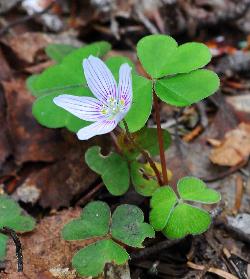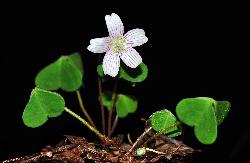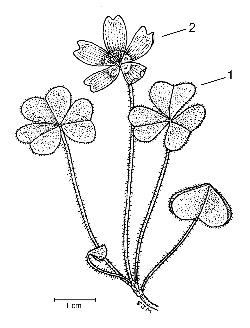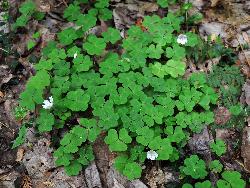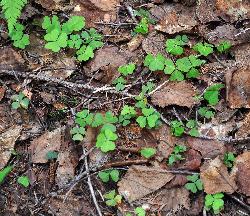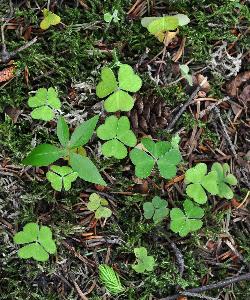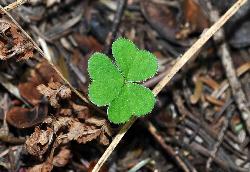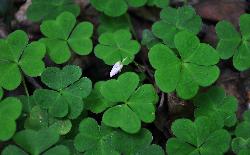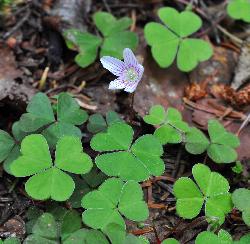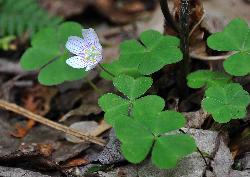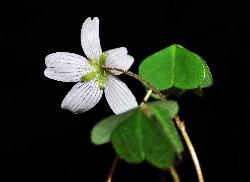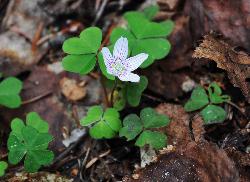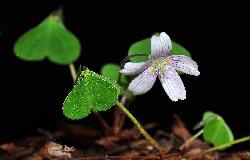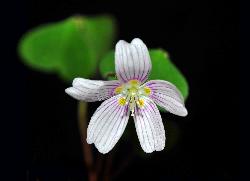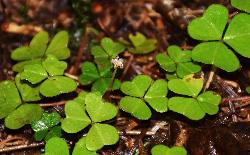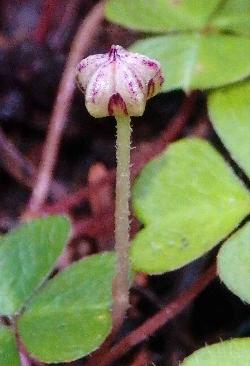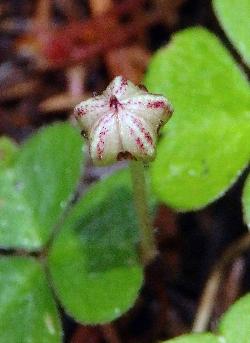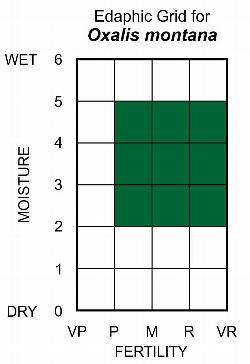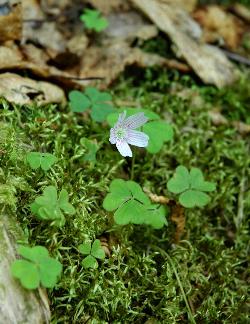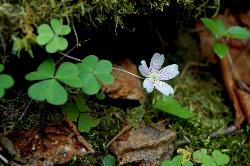Fr: oxalide de montagne, pain de lièvre
Oxalidaceae - Wood Sorrel Family
Note: Numbers provided in square brackets in the text refer to the image presented above; image numbers are displayed to the lower left of each image.
General: A low perennial scapose forb with attractive pink-striped white flowers and clover-like leaves [1–3]. Northern woodsorrel is very rare in Newfoundland and Labrador, but is a common understorey plant in boreal red spruce-balsam fir stands in mainland Canada. It is very shade-tolerant and produces scaly rhizomes that give rise to new plants (Pavel 1992).
Northern woodsorrel has often been placed in synonymy with the European common woodsorrel, Oxalis acetosella L., but is again recognized as a distinct species (Brouillet et al. 2010+).
Key Features: (numbers 1–2 refer to the illustration [4])
1. Leaves basal, trifoliolate, and petiolate.
2. Flowers scapose, the white petals are marked on the inner surface with pink lines that radiate from a yellow blotch at the base of the petal.
Stems: Northern woodsorrel plants lack above-ground stems, but do develop creeping scaly rhizomes that can produce extensive clones [5].
Leaves: Basal, trifoliolate, pinnately veined, and hairy; the slender petioles are 4–6 cm long, and have enlarged fleshy bases. The 3 leaflets are obcordate, each 1.3–3 cm wide, with a broadly cuneate base and retuse apex; margins are entire [6–8]. The petiole, surface of the leaflets, and margins are strigose-pubescent, with short straight appressed hairs.
Flowers: Bisexual; 1–3 flowers are borne singly on slender scapes, to 10 cm tall, equal in height or slightly taller than the leaves; scapes arise from the fleshy petiole bases (Jasieniuk and Lechowicz 1987). Flower buds are lanceoloid and borne on scapes that arch slightly above the leaves [9]. Mature flowers are radially symmetric (actinomorphic), about 2 cm across, and have an open, saucer-shaped corolla [10–11]. Flowers have 5 green sepals that are elliptic to oblong and shorter than the petals [12]; the 5 white petals are elliptic to obovate, blunt (obtuse) to notched (retuse) at the apex, and marked with several parallel veins that radiate upwards from the base and serve as nectar guides, a yellow spot occurs near the base of each petal, marking the location of the nectaries (Jasieniuk and Lechowicz 1987); above each yellow spot the veins become pink, forming diffuse pinkish halo-like borders around the nectaries before continuing towards the apex of the petal [13–14]. There are 10 stamens and a single pistil with 5 carpels and 5 distinct styles [15–16]. Flowering of these typical chasmogamous (open to cross pollination) flowers lasts for 3–5 weeks in early summer. In addition to these, small cleistogamous flowers, which are self-fertilizing (autogamous), develop later in the season on short recurved branches at the base of the plant; these flowers developed over a longer time period (7–10 weeks) and produce more seeds than chasmogamous flowers (Jasieniuk and Lechowicz 1987).
Through their pollination experiments with fine mesh enclosures place around plants, Barrett and Helenurm (1986) found that chasmogamous flowers from which pollinators had been excluded, still set a small amount of seed, indicating that northern woodsorrel plants are capable of self-fertilization, although cross pollination does increase seed set in chasmogamous flowers. Pollination is primarily by insects (entomophily), with documented solitary bees (Dialictus sp.) and syrphid flies (Melanostoma sp., Cheilosia pallipes Lw.) documented as the primary pollinators of northern woodsorrel in central New Brunswick (Barrett and Helenurm 1987); small beetles (Eusphalerum spp.) were also documented visiting the flowers several times.
Fruit: A small 5-lobed globose capsule [17–19], 2–4 mm long, containing 1–5 small seeds; capsules are whitish, marked with purple spots along the edges of each carpel. The loculicidal valvate capsules dehisce explosively (ballochory), shooting seeds up to 1 m in all directions (Helenurm and Barrett 1987, Jasieniuk and Lechowicz 1987).
Ecology and Habitat: Northern woodsorrel, although a common understorey species throughout most of the eastern Canadian boreal forest, is very rare Newfoundland and Labrador. It was not recorded in any of the vegetation types described in the forest classification for insular Newfoundland, but Wilton (1965) records it as a component of his Fir-Spruce-Birch/Rich Herb Forest type. He describes the understorey as having a wide variety of herbs, but with low cover. Common companion species include: Cornus canadensis, Maianthemum canadense, Clintonia borealis, Trientalis borealis, Neottia (Listera) cordata, Goodyera repens, and Dryopteris carthusiana (spinulosa). He observed, "In some areas, usually those most protected, Oxalis montana is present in small patches." Damman (1965) suggested that the northern woodsorrel and several other rarer species restricted to western Newfoundland were probably more widely distributed during the warmer early post-glacial hypsithermal period, but are now restricted to the warmest parts of the west coast. At the time, he speculated that it was restricted to two locations on the southwest coast because it couldn’t cross the wide barren expanses to the north. However, it has since been found in the Bonne Bay area.
Edaphic Grid: See image [20]: the Edaphic Grid for Oxalis montana.
Forest Types: Northern woodsorrel is not included in any of the forest types of Newfoundland, but it does occur in the Fir-Spruce-Birch/Rich Herb Forest type in Labrador described by Wilton (1965).
Succession: The following description of the ecology of northern woodsorrel is derived from the existing literature on populations outside of Newfoundland and Labrador. It must be noted, particularly for the management of rare species, that a species at the edge of its range can have a very different ecological amplitude compared to the main population. Northern woodsorrel is a shade-tolerant forb usually associated with mature forests and is listed as a climax understorey species in red spruce-balsam stands in the Appalachians of eastern North America (Pavek 1992). It can also occur on cutovers and other clearings; invading disturbed sites primarily through seeds and spreading vegetatively by rhizomes (Pavek 1992). In eastern Canada, it can be found in a wide range of boreal forest types, but it is most frequent and abundant on moist sites with conifer-hardwood mixtures. In Québec, Oxalis montana is most frequent on moist to somewhat wet, medium to rich sites (Blouin and Berger 2004). Similarly, it is listed in Ringius and Sims (1996) as a good indicator of fresh to moist, nutrient medium to rich, subacidic soils.
Distribution: Woodsorrel is a north-temperate species native to eastern North America. It occurs rarely in Newfoundland and Labrador, but is more frequent from Nova Scotia west to northern Ontario (Kapuskasing, 49° 24' N) (Scoggan 1978). Within the Province, it has been recorded from a few locations on the south shore (Rouleau and Lamoureux 1992), and in western Newfoundland; it is also known from only one general location in central Labrador, within the Lower Churchill River valley, west of Gull Island [21–22]. In the United States, it extends from Maine south along the Appalachians to northern Georgia, and west to northeastern Minnesota (USDA, NRCS 2016).
Similar Species: The trifoliolate leaves of woodsorrel are very distinct and seldom confused with other forest species. Clovers (Trifolium spp.), which are also trifoliolate, are seldom found in forested habitats, but their leaves can be differentiated by their shape – clover leaflets are ovate to rounded, with blunt to rounded apices and often marked with a pale chevron across the surface, while the leaflets of Oxalis have an obcordate apex and are solid green. In bloom, clovers are easily identified by their capitate cluster of small white, pinkish, or purple flowers, which are irregular (zygomorphic) and have 5 petals. Other Oxalis species in Newfoundland and Labrador are introduced and rarely found in forested habitats; these can be recognized by their recumbent to somewhat erect stems, smaller leaves, and yellow flowers that lack a pink spot at the base of each petal.



